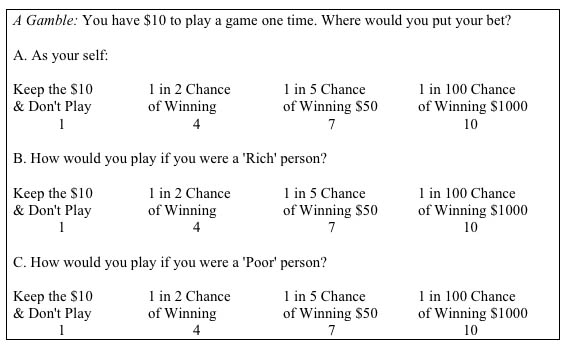 |
April 2009
|
April 2009 // Volume 47 // Number 2 // Tools of the Trade // v47-2tt2
Riskometer—Voting with Your Feet
Abstract
As Extension professionals, we are faced with the need to educate youth and adults about risk and to assess their preference for risk; however, many find the concepts difficult to illustrate. This article lays out a simple technique that can be used to illustrate how personal attitudes toward risk change with changes in situations. Youth and adults who participate in the exercise will have a better understanding of risk and their attitudes about risk, which will lead them to make personal choices that are right for them.
Introduction
Reaching the right decision is based on one's knowledge of current and potential risks and one's assessment of those risks. Youth and adults who understand risk, and their attitudes about risk, are more likely to make personal choices that are right for them. As Extension professionals, we are faced with the need to educate youth and adults about risk and to assess their preference for risk; however, many find the concepts difficult to illustrate. The following exercise can be used with youth and adults to illustrate how personal attitudes toward risk change with changes in life decision situations. The exercise was adapted from the DARE to be You Guidance Curriculum (Miller-Heyl, 1987).
Materials
Riskometer: Construct a Riskometer using a long sheet of paper approximately 18-feet long. The Riskometer will have 1 ½-foot sections numbered 1 through 10. Place this Riskometer on the floor in an area where there is sufficient room for the group to stand around it.
Worksheet with dilemma: Develop a worksheet with two dilemmas. The first dilemma is designed to demonstrate that choices are conditional (Example 1). The second dilemma is customized based on the specific program outcomes in which this exercise is used (Example 2), and it is designed to demonstrate that attitude about risk changes as situations change.
Example 1.
Demonstration of Conditional Choices
Example 2.
Customized Choices
Setup and Implementation
Pass out a dilemma worksheet to each participant. Inform the participants that they are going to play a game that will let them find out what kind of risk takers they are. Explain that the first dilemma is like a TV game where they, as participants, have each been given $10 to play any way they want. Read the choices of the first dilemma, asking the participants to respond by placing an 'X' in the box they choose. Ask the participants to play the first dilemma three times: as themselves, as a rich person, and as a poor person. This will establish that how they "risk" their $10 is conditional.
After all of the questions have been answered on the worksheet, have the group move to the Riskometer on the floor. Tell participants this is how to "measure" what kind of risk taker they are in comparison with other participants. Explain that the numbers on their chart correspond to the numbers on the Riskometer. Reread the questions, and have the participants stand around the numbers they checked on their worksheet.
Make sure the participants understand that there are no right or wrong answers. There should be a lot of movement on the Riskometer as the instructor reads through the questions. During the activity, point out that usually one or two people end up by themselves. This can be used to discuss the feelings of being different in relationship to peer pressure. To facilitate discussion among the group after the first section, you may ask:
- What did you change when the circumstances changed?
- Would you have made a different decision if you could have seen what everyone else was doing?
- If you were "different" (in the minority on a choice) how did you feel?
After completing the second dilemma, it is important to make the following points.
- Different situations have different risks.
- One's attitude toward risk changes as conditions change.
- What feels right for one person may not feel right for another.
This activity can be adapted for specific programming: ethics training, decision-making, values clarification related to environmental issues, and a variety of youth development programming.
References
Miller-Heyl, J. L. (1987). DARE to be You Guidance Curriculum (1st ed.). Colorado State University Cooperative Extension. Cortez, CO.




